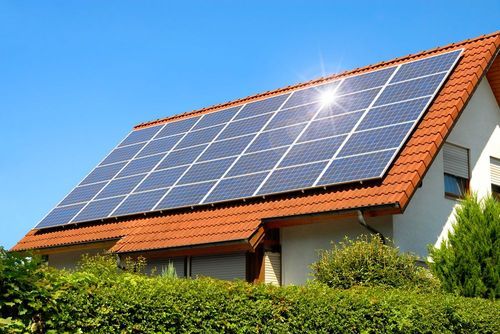Off-grid solar system: What is it
As the demand and prices of electricity have kept on rising, the world looks at the renewable energy sources for its power demands. In recent years, solar energy has become a popular renewable energy source because of its falling costs and improving efficiencies. For many people, powering their homes or small businesses using an off-grid solar system makes economic sense and appeals to their environmental values.
Off-grid solar means meeting all your energy needs from the power of the sun—with no help from the electrical grid. To make this possible, you need to install a solar power system paired with an energy storage system, like a solar battery, at the site of power consumption (your home).

The components of off-grid solar system
An off-grid solar system is more popular and comes with a power backup. It works independently of the grid. Most home appliances such as electric fans, TV, cooler, water pump, etc. can work through this system. While many people think only of solar panels when they hear “off-grid solar”, the reality is that you need to add many other components to get a functioning off-grid PV system. A complete off-grid solar system is one that has all the necessary equipment to generate, store, and supply solar energy onsite.
The equipment required for a functioning off-grid solar system are solar panels, solar charge controller, solar inverters, solar battery, mounting and racking system, wiring and junction boxes.
It is the most common type of solar power system with backup. It works in day and night both, during the day, solar panel charges the battery and runs the home appliances such as air conditioners, cooler and television. At night, when the sun is not available, inverter runs your home appliances using the battery power.
The advantages of off-grid solar
Freedom from the grid
This is the primary reason why people in blackout-prone regions are interested in off-grid solar. When connected to the grid, you are dependent on an external supplier—the utility company—for all your power. When the grid shuts off, so does your power supply. However, with an off-grid solar system, you’re completely reliant on the sun or energy stored in batteries to power your home or business.
It is good for the environment
Going off-grid reduces carbon emissions. Since most of the electricity supplied through the grid comes from burning fossil fuels, producing your own power through the renewable source---solar drastically reduces your carbon footprint.
Encourages a more energy-conscious lifestyle
When you’re connected to the grid, it’s easy to be unaware of your power consumption habits—you consume electricity, pay the bill when it comes, and that’s all. It disconnects you from where the electricity is coming from and where it’s being used.
Your attitude when it comes to power changes completely when you go off-grid. In order to ensure you don’t run out of electricity, you will have to closely follow your energy generation and also re-evaluate and rationalize your energy consumption.
How to size an off-grid solar system
Deciding on the size of the system you need is an early and absolutely crucial step when it comes to installing an off-grid solar system.
It will affect the kind of equipment you need, how much work the installation will involve, and, of course, the total cost of the project. Solar setup sizes are based on the amount of power the system needs to provide.
There are two different ways to figure out the number you need, and they are based on your current usage and load evaluation.
Basing solar setup size on usage
You can use this option if your aim is to maintain your current lifestyle as you switch from grid-tied to off-grid solar. To do this, you can simply refer to your monthly power bills to determine your electricity usage in kilowatt hours.
Basing solar setup size on load evaluation
The second option is to perform a complete load evaluation to determine how much power you’ll need.
First, calculate total electricity usage needs. This allows you to calculate the power consumption of each appliance, as well as your total power consumption over a day. Knowing how many kWh in a day you’ll use will allow you to size your solar panel array, as well the solar battery storage.
And then calculate instantaneous load requirements. You’ll also have to calculate how many appliances you might run simultaneously. This will help you calculate instantaneous wattage requirements, which you need to know in order to size the inverter properly (the inverter runs the AC loads).
Finally, you need to decide on battery storage capacity. You will need to decide how much energy storage you want. Do you want to cover usage for just one day, or do you want to have extra backup capacity? When it comes to solar battery backup, the rule generally is you'd want enough storage to cover at least 2-3 days of usage during the highest usage time of year.
Off-grid solar is the most convenient energy source when it is hard (or impossible) to access the grid. It is also usually the best option to those committed to a low carbon footprint, sustainability-minded lifestyle.



































































































